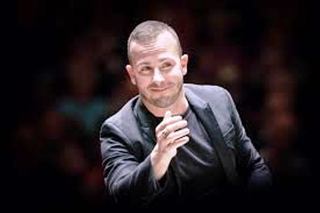|
Back
Janine Jansen’s Tsunamis of Sound New York
Isaac Stern Auditorium, Carnegie Hall
03/13/2018 - & March 8, 9, 10, 2018 (Philadelphia)
Michel van der Aa: Violin Concerto (New York Premiere)
Sergei Rachmaninoff: Symphony No. 2 in E Minor, Opus 27
Janine Jansen (Violin)
Philadelphia Orchestra, Yannick Nézet-Séguin (Conductor)

M. van der Aa/J. Jansen (©Sgt.gr/Digitalconcerthall)
“If Janine had played the flute, I would have written a flute concerto.”
Michel van der Aa, composer of Violin Concerto
Michel van der Aa is a notable media mixer. Starting as an acoustical engineer, he went into composition, came to New York to study film, and today his music merges all his talents into what is usually a big sparkling, surprising jolting phenomena.
He didn’t use those electronic-video techniques last night. With Janine Jansen, he not only had a fellow Dutch-person but a virtuoso who could put all his virtuosic composition genius into practice.
What Mr. van der Aa had in a Violin Concerto, written for Ms. Jansen and performed last night in its New York premiere were three movements that were intense, unrelenting and harsh. Yes, “harsh” was the operative word mostly for the first movement. Paul Griffith’s program notes described all the intricacies of this movement with great detail. But even without it, Ms. Jansen’s Stradivarius started with an abrasive shuddering motif, followed by more harsh, searing music by the full Philadelphia Orchestra.
One could have braced for the worst, and still be staggered by the nervousness, the pulsating colors of harp and cello and vibraphone with Ms. Jansen’s violin. He could have had an easier time, had she soared upwards with her instrument. But that was not the way with Mr. van der Aa. The colors came at the low bottoms ranges, the emotional heat was raging in its underground prison.
This was a jarring opening. One might not have appreciated the complex structure, but one knew that a huge amount of labyrinthian thought had been transferred to both orchestra and soloist.
Movement II was equally complex, but here Mr. van der Aa showed that he could be the 21st Century equivalent of a mid-19th Century Romantic. As the violin worked at a slower pace, the orchestra repeated blocks of chords, changing colors and instruments, but consistently pulling in the listener. Ms. Jansen, without a measure of rest or even quiet tension, played a lament that never became dolorous, was always alert to the forces around her.
As for Movement III, we had the fastest 16th notes that any violinist–and any orchestra–could handle. Ms. Jansen stomped and weaved her way on the stage, but those notes poured out of her and the Philadelphia Orchestra with whirling, swirling delight. Delight, virtuosic glee and demonic radiance.

Y. Nézet-Séguin (© YannickNézet-Séguin.com)
After this 25-minute miracle, Sergei Rachmaninoff–who actually was a mid-19th Century Romantic in 1906–seemed almost tame. Yet one must remember that Rachmaninoff to the Philadelphia Orchestra was like Bernstein to the New York Philharmonic. Their performances seem created for each other.
Yannick Nézet-Séguin had was almost invisible next to the legerdemain of Ms. Jansen, who towered above him. In the Rachmaninoff, he had the Philadelphians to himself. And after a perhaps too lachrymose opening, he sailed into the all marches, laments, huge climaxes and great crescendos of the Second Symphony.
One sometimes feels this work needs a chocolate-marshmallow ickiness to come alive. But Maestro Nézet-Séguin had no need for that. He had splendid solos (what fabulous cor anglais phrasing)., he had the same luscious string ensemble which both Stokowski and Ormandy had given this orchestra. And his control made the climax of the Adagio into an Everest of power.
One reflected here on pianist Daniil Trifonov’s playing of all the Rachmaninoff concertos two years ago. He had transcended the composer’s inner thoughts and given them international power. Mr. Nézet-Séguin never gave that any thought. His Rachmaninoff was amatory at times, turbulent at times. Yet he gave it all the mighty power this hour-long work deserves.
Harry Rolnick
|